#eric ogden
Explore tagged Tumblr posts
Text

Rachel Anne McAdams by Eric Ogden
35 notes
·
View notes
Photo


Mathew McConaughey photographed by Eric Ogden.
141 notes
·
View notes
Text

:. Amy Adams, Photography © Eric Ogden vía: @Jopolkadot .:
1 note
·
View note
Text

Time Out New York, 2000 Photo session Photographer: Eric Ogden
6 notes
·
View notes
Text

Fiona Apple photo by Eric Ogden, out-take from Vogue shoot
455 notes
·
View notes
Text
🔊 Sound on.
Matthew Goode photoshoots with moody/badass/bad boy vibes.
Coz he does that so well.
��� Atmosphere by Joy Division (IG music library)
📷 Photographs by (top left clockwise): Philip Sinden / Benjamin Reed / Jay Brooks / Simon Emmett / Eric Ogden / Dylan Don / John Hooper / Tomas Falmer / Claudia Pasanisi (from her website) - via matthew-goode.net unless specified otherwise.
22 notes
·
View notes
Photo







Post 0515
Eric Millerberg, Utah inmate 124835, born 1976, incarceration intake in 2015 at age 39, sentenced to 6 years to life, parole consideration date not available
Homicide, Obstructing Justice, Unlawful Sexual Contact, Corpse Abuse
A judge ordered Eric Millerberg to spend five years to life in prison for child abuse homicide, a first-degree felony; one to 15 years for obstructing justice, a second-degree felony; and two terms of zero to five years for both unlawful sexual conduct with a 16- or 17-year-old and abuse or desecration of a human body, third-degree felonies.
The judge ordered the sentences to run consecutive to each other.
"Alexis, the victim, was simply an immature victim that you took advantage of after you injected her with drugs," the judge told Millerberg. "Frankly, the conduct that bothers me the most was the conduct after, that things could have been done to make it less horrendous than it was, but they weren't."
Millerberg was convicted by a jury that took less than 90 minutes to declare his guilt.
Eric Millerberg said he was sorry for the loss to Alexis' family and that he couldn't imagine what this has done to them. Still, he stopped short of taking complete responsibility for her death.
"I'm willing to shoulder the responsibility for the role I played and the things that I have done," he said. "There's no way it's all mine."
(He is appealed the conviction, but the appeals were denied.)
The key testimony in the trial came from Millerberg's wife, Dea, who said it was Eric Millerberg who injected methamphetamine and heroin into the teenager's body. Alexis baby-sat for the couple, but her friend also testified that she and Alexis would go to them for drugs and alcohol.
The Millerbergs prepared drugs for the three of them, and they injected methamphetamine and heroin, smoked marijuana, drank alcohol and engaged in sexual activity the night Alexis died.
After Alexis took a bath at the Millerberg home, Dea Millerberg said the girl reported being really cold and shaking. Millerberg, a former nurse, didn't think much of the girl's symptoms at the time. But when Alexis became unresponsive later in the night, she tried to resuscitate her, but to no avail.
It was then that the Millerbergs "panicked" and decided to hide Alexis' body. The North Ogden girl was last seen the night of Sept. 10, 2011, when she was reportedly baby-sitting the couple's two young daughters. Eric Millerberg told both the girl's mother and a close friend that he didn't know where she was or what happened to her. Her body wasn't found until Oct. 18 in Morgan County.
Millerberg's attorney, Randall Marshall, argued that while the case is tragic, Alexis' death was not an intentional, premeditated murder. He said there was nothing to warrant the request for consecutive sentences.
"We have something that clearly was an accident," he told the judge. "No one intended for there to be a death — no one."
He said Millerberg struggled with drug and alcohol use and also questioned why his client was taking the bulk of the blame, when Dea Millerberg was also present the night the girl died and the decision was made to dispose of her body.
"The circumstances of this case are a bit suspect to begin with," Marshall said. "All the blame now rests on Mr. Millerberg for this death. … He essentially is being saddled with all the burden, all the responsibility for Lexi's death as if he was the only one involved."
Prosecutor Christopher Shaw took issue with the contention that the death was an accident and only involved one victim. He pointed to Alexis' family and said he wasn't about to tell them there was only one victim in the case.
"Intentionally injecting heroin and methamphetamine into a young girl is not an accident," he argued. "This is no accident. This is child abuse homicide. That's clear in the record, it's clear in the facts. That's what happened here."
He said Millerberg has failed to take responsibility for his actions in the teen's death and pointed to his long criminal history, which includes several felonies and failed probation opportunities.
"It's clear he doesn't respect rules and never has," Shaw said. "This defendant has had every opportunity to clean up and he chose not to. He chose to provide those illicit drugs to a 16-year-old. … It isn't by chance that Mr. Millerberg winds up here, it is by choice."
Weber County Attorney Dee Smith said he hopes the sentence sends the message to the Utah Board of Pardons and Parole that Millerberg is a dangerous person who should never be released from prison.
Alexis' mother, Dawn Miera, said the sentencing "went as best as it could go."
3j
58 notes
·
View notes
Text

Chris: Horror in the High Desert is a suspense / horror found footage film about an explorer of the countryside who disappears after finding a spooky remote shack, kept my attention, higher quality film than many horror films, and looking forward to seeing the sequel this week, Watch: On Subscription Service.
Richie: It’s a good found footage movie, and the final act is great but leaves many unanswered questions, hopefully the sequel will answer some of them, Watch: On Subscription Service.
2 notes
·
View notes
Text
axiom for plots and miracles
Axioms enjoyable to me prove to be harder to identify as negative ones. Subjective too. It appears shortsighted to invert "bad" axioms, as some escape binary concepts.
R. F. Kuang made an impression, in a recent release¹, postulating that plots rooted almost in absurdism depend on the confidence of the writer. Examplified by John Wick, the entirety of the story will fall appart if the main character analyzes the comparativeness of motivations. Hence, the premisse is treated similar to Zimmermans² idea of the magic circle (which is derived from Huizinga and Caillois), in which every notion of tdoubt is exluded from the world. To formulate a rule out of this appears insufficient, as the short story The Cold Calculations³ qualifies but leaves an unsatisfied aftertaste as it uses an unexplainable miracle to arrange the plot twist. Maybe I wasn't reading careful enough, but it appears that adding food for thought or surreal elements that could be called plot holes, seem to be outside of this realm as long as they do not pull the plot into a direction without apparent causality, hence not annoying me as a reader. Overall, I am very happy over stumbling upon this story though as the aspect of superimposition of the writing between dialogues is something I'm looking forward to adapt into my arsenal.
I'm also under the impression that this might be the reason I personally do not vibe with Neil Gaimans "The Ocean at the End of the Lane". The question remains for me if this is a large divider in reading preferences similar to genres. Summarizing, the best appraoch appears to be still to write something that I'd like to read myself. ¹ Kuang, R. F.., Adams, John Joseph. The Best American Science Fiction and Fantasy 2023. USA: HarperCollins, 2023. ² Zimmerman, Eric, Jerked Around by the Magic Circle - Clearing the Air Ten Years Later, 2012 Gamasutra. ³ Aimee Ogden, The Cold Calculations, Clarkesworld, 2021. https://clarkesworldmagazine.com/ogden_12_21/
0 notes
Text
The Discharged videogames is on display at Ogden Fine Arts as part of Eric J. Garcia's Aim High exhibition.
0 notes
Text
PRINCESAS DISNEY

Las Princesas Disney, o también llamada Línea de Princesas, es una franquicia de La Compañía de Walt Disney formada por heroínas de diversas películas, comúnmente princesas o que llegan a convertirse en princesas en el desarrollo de sus respectivas películas.
Cantidad de Princesas Disney
Disney tiene 15 princesas, quienes son: Cenicienta, Blancanieves, Aurora, Bella, Rapunzel, Jasmine, Ariel, Tiana, Pocahontas, Mulán, Mérida, Anna, Elsa, Moana y Raya.
Nacionalidad de las Princesas Disney
Cenicienta, Francia – Alemania (El origen de Cenicienta está un poco peleado, pues hay quienes dicen que es de Francia y otros que es de Alemania).

Blancanieves, Lohr am Main, Alemania

Aurora, Francia

Bella, Francia

Rapunzel, Alemania
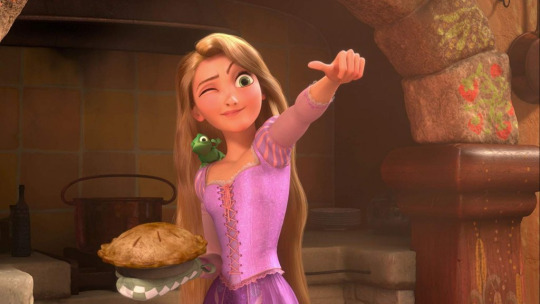
Ariel, Dinamarca

Jasmine, Oriente Medio (vive en Agrabah, una ciudad ficticia; sin embargo debido a varios elementos que aparecen en el filme, sabemos que este lugar se encontraría en Oriente Medio).
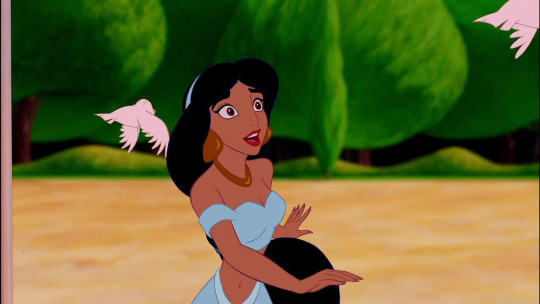
Tiana, Nuevo Orleans, Estados Unidos
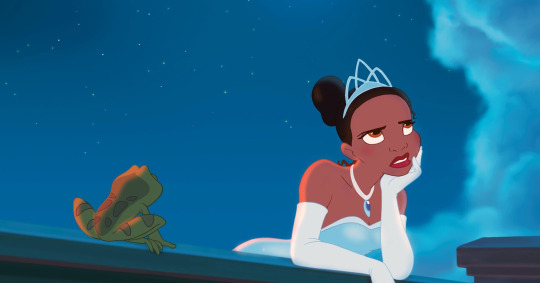
Pocahontas, Virginia, Estados Unidos

Mulán, China

Mérida, Escocia
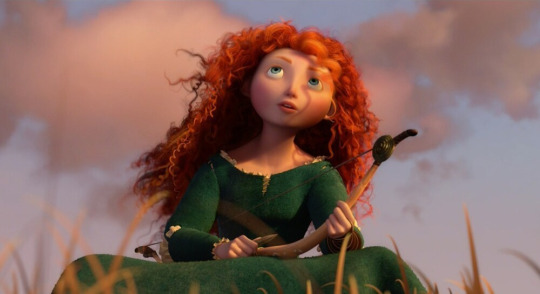
Anna y Elsa, Noruega

Moana, Pacífico Sur (vive en una isla del Pacífico Sur)

Raya, Sudeste Asiático (Está ambientada en el país ficticio de Kumandra, que se basa en culturas reales del Sudeste Asiático, como la Tailandesa, la Malaya y la Vietnamita)
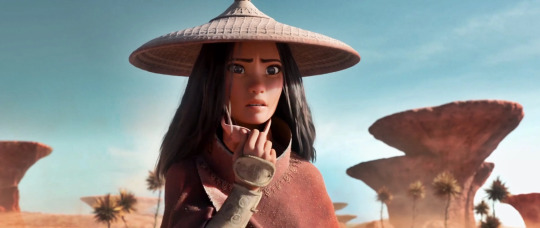
Años de estrenos de las Películas de las Princesas Disney (en orden cronológico) y Datos Curiosos
Blancanieves y los 7 enanos (1937)
Datos curiosos:
Blancanieves tiene tan sólo catorce años, por lo que es la princesa más joven.
Se escribieron 25 canciones para la película, pero sólo utilizaron ocho.
El príncipe debía tener mayor presencia en la película, pero la dificultad al animarlo hizo que redujeran su participación.
Cenicienta (1950)
Datos curiosos:
El nombre completo de Gus (el ratón) es Octavio, presuntamente por el nombre privado del emperador romano Augusto. Gus puede ser diminutivo de Gustavo o Augusto.
La transformación del vestido desgarrado de Cenicienta fue considerada la pieza de animación favorita de Walt Disney.
Es la primer película de Disney donde trabajaron los nueve legendarios «Nine Old Men» del departamento de animación.
La Bella Durmiente (1959)
Datos curiosos:
La discusión entre Flora y Primavera por el color del vestido simula el conflicto que tuvo el cineasta al decidir de qué color quería que fuera el vestido de Aurora.
Aurora, la protagonista, sólo tuvo 18 líneas en toda la película.
El libro que sale al principio era real y estaba hecho a mano por Eyvind Earle, el encargado de la apariencia de la película.
La sirenita (1989)
Datos curiosos:
Jodi Benson cantó «Part of your world» a oscuras para simular estar bajo el agua.
Jim Carrey audicionó para el papel del Príncipe Eric.
Existe un debate en el cual se discute si Ursula es un calamar o un pulpo debido al número de tentáculos que tiene. En la película sólo salen seis tentáculos porque era muy caro dibujarlos. Aún así se dice que sus brazos podrían contar como los faltantes.
La Bella y la Bestia (1991)
Datos curiosos:
Es la primer película animada (después llegó UP) en ser nominada para el premio de la Academia a Mejor Película.
El vestido azul y el peinado de Bella están inspirados en Dorothy de El mago de Oz.
La frase de Din Don «Flores, chocolates, promesas que no intentas cumplir» fue improvisada por David Ogden Stiers.
Aladdín (1992)
Datos curiosos:
Debido a que Robin Williams improvisó la mayoría de sus diálogos, el guión fue rechazado para la nominación a Mejor Guión Adaptado.
Inicialmente, Aladdín sabía que Jasmine era una princesa cuando la conoció, sin embargo el equipo de producción lo cambió porque podía implicar que Aladdín sólo se interesó en ella por su dinero y poder, y no porque realmente la quisiera.
Abu (el mono) obtuvo ese nombre en honor a la ciudad egipcia de Abu. Esto se traduce a «elefante», porque la ciudad era conocida por su comercio de marfil. Por lo tanto, no es sorprendente que, cuando lo transforman, Abu cambie de forma a un elefante.
Pocahontas (1995)
Datos curiosos:
La película se estrenó el 23 de junio de 1995, justo cuando se cumplían 400 años del aniversario del cumpleaños de Pocahontas.
Pocahontas es una de las dos únicas princesas de Disney que nacieron en Estados Unidos, la otra es Tiana de La princesa y el sapo (2009).
Originalmente, Pocahontas iba a tener 3 compañeros animales: un mapache llamado Meeko, un colibrí llamado Flit y un pavo llamado Redfeather. En producción se decidió quitar a Meeko y dejar a los otros dos, pero debido a la muerte de John Candy (quien prestaría la voz a Redfeather) Meeko volvió.
Mulán (1998)
Datos curiosos:
En una versión de la leyenda, Mulán tenía un hermano más joven que estaba alistado en el ejército. En la película ella tiene un perro llamado «Hermanito» como un guiño a eso.
Esta fue la última película animada de Disney en tener elementos musicales después de una década de musicales animados de Disney hasta La princesa y el sapo (2009).
Mulán es la única princesa de Disney que no es de la realeza.
La Princesa y El Sapo (2009)
Datos curiosos:
El cocodrilo obtuvo el nombre de Louis en honor al gran Louis Armstrong.
La estrella a la que Ray nombre «Evangeline» es, de hecho, el planeta Venus, llamado así por la diosa romana del amor.
Beyoncé fue considerada para el papel de Tiana, pero lo perdió porque se negó a hacer audición.
Enredados (2010)
Datos curiosos:
El diseño de Flynn salió del proceso llamado «hot man meeting» de Nathan Greno y Byron Howard. En este, hicieron una junta con todas las empleadas del estudio en un cuarto y les preguntaron su opinión respecto a qué hacía atractivo a un hombre. Un video mostraba, en las paredes del cuarto, el arte conceptual y las fotos de varias celebridades masculinas, incluyendo a Johnny Depp, Hugh Jackman, Brad Pitt, David Beckham y Gene Kelly.
Para la escena en donde Rapunzel entra al pueblo, los animadores se inspiraron en las entradas de Walt Disney World y Disney Land. La emoción de Rapunzel se basa en la reacción de los niños en los parques.
Originalmente, el nombre del héroe iba a ser Bastian.
Valiente (2012)
Datos curiosos:
Esta es la primer película de Pixar que tiene a una mujer protagonista y es el primer personaje de Pixar que se incluye en la línea oficial de Princesas Disney.
El título original de la película iba a ser «The Bear and the Bow» (El oso y el arco).
El nombre del oso malvado, de la leyenda que cuenta la Reina, es Mor’du. En gaélico se escribiría Mor Dubh que significa el grande negro.
Frozen (2013)
Datos curiosos:
En diseños anteriores, el monstruo gigante de nieve que Elsa crea era una versión gigante de Olaf, a quien llamada «pequeño hermano». Esto no se utilizó, ya que a pesar de parecer lindo y divertido, también era algo tonto.
Aparte de ser la primer mujer que dirigía un largometraje animado de Disney, Jennifer Lee también se convirtió en la primer mujer en escribir un guión entero para una película de Disney desde Linda Woolverton para La bella y la bestia (1991).
El soundtrack de Frozen estuvo 13 semanas no consecutivas en el primero lugar de Billboard 200.
Moana (2013)
Datos curiosos:
Lin-Manuel Miranda ha dicho que el personaje de Tamatoa, el cangrejo gigante, es un tributo a David Bowie.
Esta es la primera película de Disney con un elenco mayoritariamente polinesio: Dwayne Johnson, Auli’i Cravalho, Rachel House, Temuera Morrison, Jemaine Clement, Nicole Scherzinger, Oscar Kightley y Troy Polamalu.
Los directores, John Musker y Ron Clements, investigaron durante meses, y se sumergieron en la cultura polinesia para que la película respetara su cultura y la mitología.
Raya (2021)
Datos curiosos:
Raya y el Último Dragón se desarrolló casi enteramente de forma remota.
La comida ocupa un lugar central en la película.
Se crearon más de 72 mil elementos animados para crear Kumandra.
Estadísticas
La Princesa más popular de Disney es Elsa de FROZEN, aunque en realidad Elsa es una reina; la Princesa que vende más es Moana; la Princesa más rentable es con Bella de La Bella y La Bestia, película que recaudó más de 420 millones de dólares en todo el mundo; la Princesa más querida es Cenicienta; la Princesa menos querida es Aurora de La Bella Durmiente, etc.
Princesas que tienen Live Action
Cenicienta (Cenicienta), Bella (La Bella y La Bestia), Jasmine (Aladdín), Mulán (Mulán), Ariel (La Sirenita) y Aurora (Maléfica).
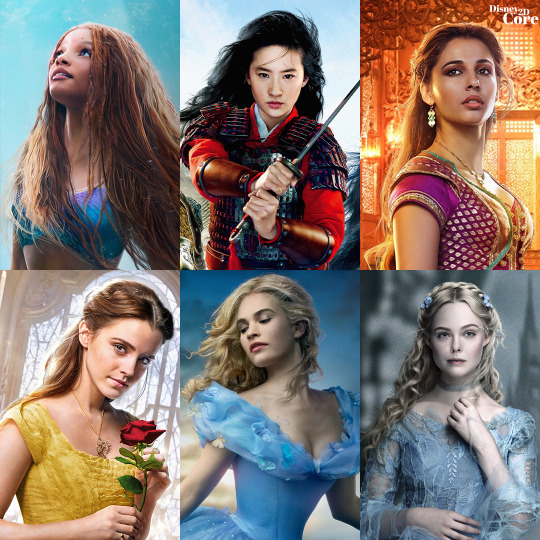
Y como mención especial:
Anastasia, Rusia
Anastasia no es una princesa Disney, sin embargo como la franquicia de Disney adquirió los derechos de Fox, quien creó la película de Anastasia, este filme ya forma parte del mundo de Disney.
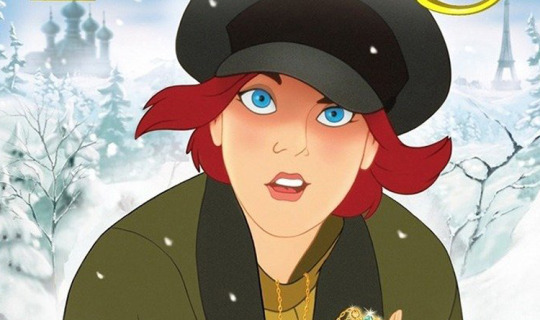
Referencias bibliográficas:
Princesas Disney. (2019, 21 mayo). Wikipedia.org. Recuperado 22 de agosto de 2023, de https://es.wikipedia.org/wiki/Princesas_Disney#cite_note-1
¿De dónde son las princesas Disney? (2020, 3 abril). alanxelmundo.com. Recuperado 22 de agosto de 2023, de https://alanxelmundo.com/de-donde-son-las-princesas-disney/#:~:text=Disney%20tiene%2014%20princesas%2C%20quienes,%2C%20Anna%2C%20Elsa%20y%20Moana.
Guía para padres sobre Raya y el último dragón. (2022, 15 diciembre). common sense media.org. Recuperado 22 de agosto de 2023, de https://www.commonsensemedia.org/es/resenas-pelicula/raya-y-el-ultimo-dragon#:~:text=Las%20familias%20necesitan%20saber%20que,tailandesa%2C%20la%20malaya%20y%20la%E2%80%A6
Princesas de Disney, lista completa y datos curiosos. (2021, 19 julio). cinepremiere.com.mx. Recuperado 24 de agosto de 2023, de https://cinepremiere.com.mx/princesas-de-disney.html
Las 4 curiosidades sobre la película Raya y el Último Dragón. (2023, 23 enero). disneylatino.com. Recuperado 24 de agosto de 2023, de https://www.disneylatino.com/novedades/las-4-curiosidades-sobre-la-pelicula-raya-y-el-ultimo-dragon
Ni Ariel ni Cenicienta: un estudio reveló a la princesa más popular de Disney. (2021, 19 septiembre). univision.com. Recuperado 24 de agosto de 2023, de https://www.univision.com/entretenimiento/cultura-pop/ni-ariel-ni-cenicienta-un-estudio-revelo-a-la-princesa-mas-popular-de-disney
¿Cuál es la princesa Disney preferida por la compañía? (2022, 12 febrero). hobbyconsolas.com. Recuperado 24 de agosto de 2023, de https://www.hobbyconsolas.com/reportajes/princesas-disney-mas-rentables-1003413
¿Quién es la princesa de Disney que menos le gusta? (2023, 1 enero). celebrity.fm. Recuperado 24 de agosto de 2023, de https://celebrity.fm/es/who-is-the-most-disliked-disney-princess/
Todos los remakes en acción real de Disney, ordenados de menor a mayor calco. (2023, 27 mayo). 20minutos.es. Recuperado 24 de agosto de 2023, de https://www.20minutos.es/cinemania/noticias/todos-los-remakes-en-accion-real-de-disney-ordenados-de-menor-a-mayor-calco-132995/
Cecilia Estefanía Martín del Campo Hernández Ciencias de la Comunicación Profesor Eddy Ríos Martínez
1 note
·
View note
Photo

Time Out New York, 2000 Photographer: Eric Ogden
27 notes
·
View notes
Text

Fiona Apple photo by Eric Ogden for Vogue, 2005
278 notes
·
View notes
Text
🔊 Sound on
A Goodemas cheese fest with Matthew wearing his best festive jumpers. So adorable.
🎶 All I Want for Christmas is You by Mariah Carey (there is never enough cheese 😁)
📷 My video edit from photographs by Chris Mc Andrew / Philip Sinden / Matteo Montinari / Peggy Sirota / Uli Weber / Piotr Redlinski / Brent Helsel / Peggy Sirota / Eric Ogden / Austin Hargrave
All from matthew-goode.net with thanks.
16 notes
·
View notes
Text
Monday, March 06, 2023 Canadian TV Listings (Times Eastern)
WHERE CAN I FIND THOSE PREMIERES?: HISTORY OF THE WORLD, PART II (Disney + Star) 9-1-1 (Global) 8:00pm THE VOICE (CTV2) 8:00pm SPRING BAKING CHAMPIONSHIP (Food Network Canada) 8:00pm PERRY MASON (HBO Canada) 9:00pm SPRING BAKING CHAMPIONSHIP EASTER (Food Network Canada) 10:00pm ROCK THE BLOCK (HGTV Canada) 10:00pm RAIN DOGS (HBO Canada) 10:00pm
NEW TO AMAZON PRIME CANADA/CBC GEM/CRAVE TV/DISNEY + STAR/NETFLIX CANADA:
CBC GEM BACKLASH: MISOGYNY IN THE DIGITAL AGE ROAD TO THE JUNOS: SHAELA MILLER ROAD TO THE JUNOS: D'ORJAY THE SINGING SHAMAN
CRAVE TV PERRY MASON (Season 2) RAIN DOGS
DISNEY + STAR HISTORY OF THE WORLD PART II (series)
NETFLIX CANADA RIDLEY JONES (Season 5)
CURLING (TSN) 9:00am: 2023 Tim Hortons Brier: Pool Play (TSN) 2:00pm: 2023 Tim Hortons Brier: Pool Play (TSN) 7:00pm: 2023 Tim Hortons Brier: Pool Play
MLB BASEBALL (SN) 1:00pm: Tigers vs. Red Sox
NBA BASKETBALL (SN Now) 7:00pm: Celtics vs. Cavaliers (TSN3/TSN4) 9:00pm: Raptors vs. Nuggets
NHL HOCKEY (SN) 7:30pm: Oilers vs. Sabres (SN1) 7:30pm: Sharks vs. Jets (SNFlames) 8:30pm: Flames vs. Stars (TSN5) 9:00pm: Sens vs. Chicago (SNPacific) 10:30pm: Predators vs. Canucks (SN1) 10:30pm: Capitals vs. Kings
MURDOCH MYSTERIES (CBC) 8:00pm: Nearly exonerated, Ogden is implicated in the warden's murder; Murdoch delves into the death of a fraternity pledge.
SECRETS, LIES AND DNA TIES (Super Channel Fuse) 8:00pm (SERIES PREMIERE): Chris wants to know who his real father is; Matt wants to know if his girlfriend is cheating on him.
PLAN B (CBC) 9:00pm: Despite working hard to make it perfect, Philip’s life still isn’t going according to plan.
HEAVY RESCUE: 401 (Discovery Canada) 10:00pm: Eric and Senior work to coax a semi back on the road.
#cdntv#cancon#canadian tv#canadian tv listings#murdoch mysteries#plan b#heavy rescue: 401#curling#mlb baseball#nba basketball#nhl hockey
0 notes
Text

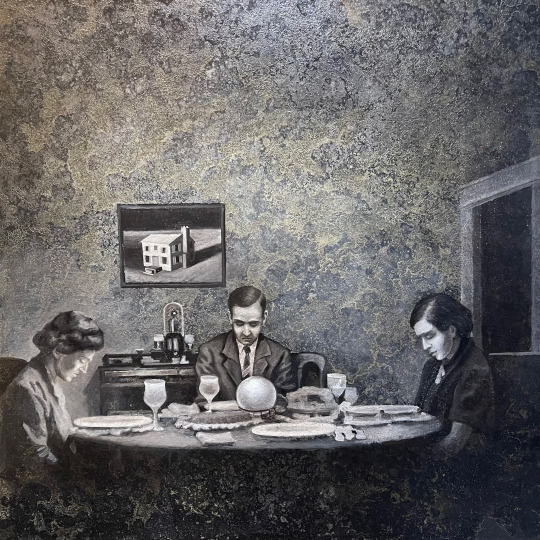

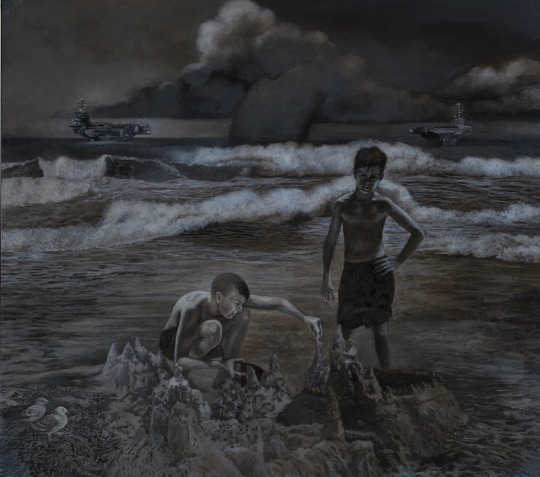


ALEXANDER STOLIN, born and raised in Kiev, Ukraine (under the former Soviet Socialist Republic), where he received intensive training and a master of fine arts degree in his homeland’s traditional art academies. As art critic D. Eric Bookhardt suggested in 2002, “Stolin is more accomplished than he is famous.” His art, often exhibited in thematic series that incorporate a variety of media, ranges from intimate portraits to large-scale murals (one measuring twelve feet by seventy-two feet). He has worked on a progressively larger scale, most recently designing and painting projects for the Louisiana film industry. Stolin’s technically proficient and complexly layered art reflects a unique fusion of the academic training he received in Kiev and his evolving response to the very different culture, lifestyle, and subject matter he has discovered in New Orleans, Madisonville, and the Gulf South.
Stolin’s Face to Face series of portraits, completed from 2000 to 2002, featured New Orleans artists including Douglas Bourgeois, Jeffrey Cook, and Margaret Witherspoon and the architect Jimmy Lamantia, as well as his Madisonville neighbors, including Bud Goldate, Hascal Agee, and Willie Lee Marshall. These were important works, exhibited at the Ogden Museum of Southern Art when it opened in 2003. “There are portraits—and there are portraits,” said Bookhardt, referring to the series. “The best tell us something essential about the subject. The rest are just pictures.” Observing that Stolin’s work “offers insights into the processes of perception,” Bookhardt concluded that “his images distill something of the subject’s life essence filtered through the eye and hand of an unusually skilled, sensitive, and increasingly accomplished painter.” A diversified range of works followed, including an exploration of his childhood memories of Kiev, enhanced by family photographs and a series of letters from Kiev to relatives in America. Stolin juxtaposed the historic and vernacular architecture of Kiev with New Orleans buildings of the same period, as is evident in a painting such as Waiting II. Another series explored the marshes and landscapes of the north shore of Lake Pontchartrain. Stolin also painted genre scenes of small-town life in Madisonville, becoming, in his own way, a southern regional painter. Works in this series included Bayou Lacombe, Breakfast at Badeaux’s, and Jr. High at Madisonville, which featured a painted image of the school’s retired bus and metal from the actual bus, fusing art, history, memory, and reality.
The art Stolin began to create in New Orleans demonstrated his technical skills, knowledge of art history, and the evolving range of his subject matter, reflected from one series and exhibition to the next, yet it was challenging for critics to classify his work. This was evident in the series Stolin exhibited during his first decade in the city, beginning with Byzantium on the Bayou (1993–1994), which combined historical Byzantine art references with New Orleans and Mardi Gras subjects, such as Mardi Gras Madonna and Adoration of St. Gator. In his Midnight Dessert series (1995–1997), he created works such as Tea in Manhattan and Rembrandt and Nathan, a large painting that Bookhardt described as “a vision of Rembrandt and various Dutch masters promenading down the sidewalk past Nathan’s Deli in New York.” Following that, he completed The Water Series (1998–1999), featuring reflective and heavily worked surfaces in paintings such as Reflections #2 and Study of Fish and Swimmers.
Stolin exhibited for years with the Marguerite Oestricher Gallery in New Orleans. After its closing he became associated with the Taylor-Bercier Gallery in New Orleans and continues to exhibit his art across Louisiana. His works are included in the collection of the Ogden Museum of Southern Art in New Orleans as well as in numerous corporate and private collections.
#alexander stolin#ukraine artist#contemporary art#history art#oil art#jonathan ferrara gallery#jfg artist
1 note
·
View note